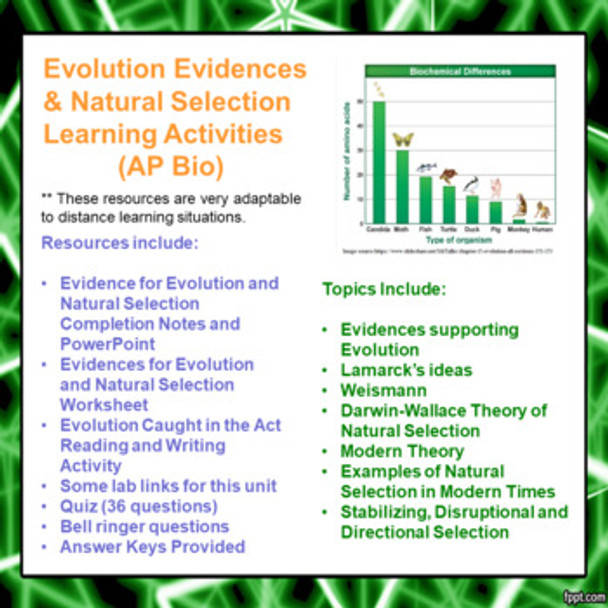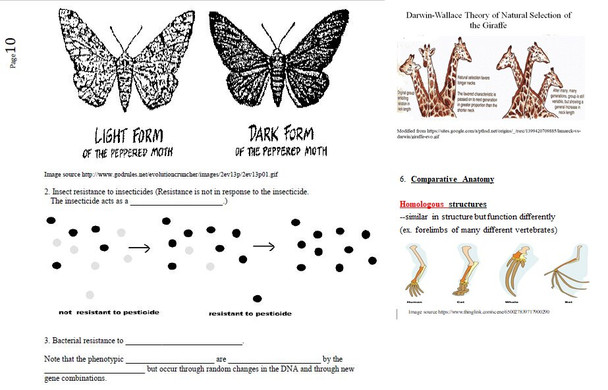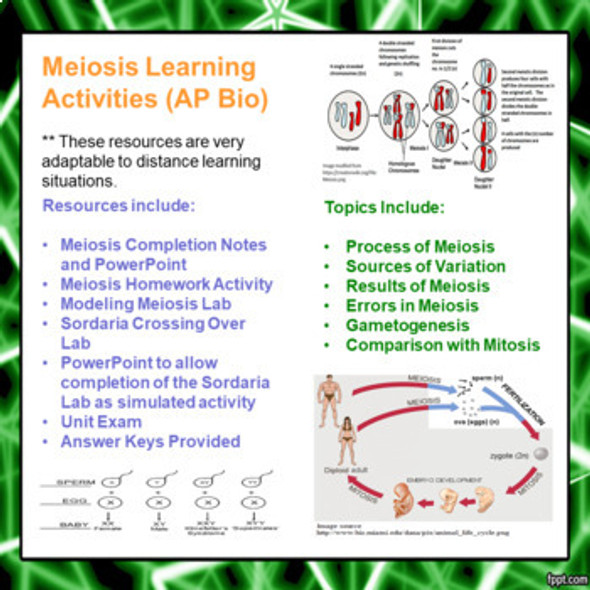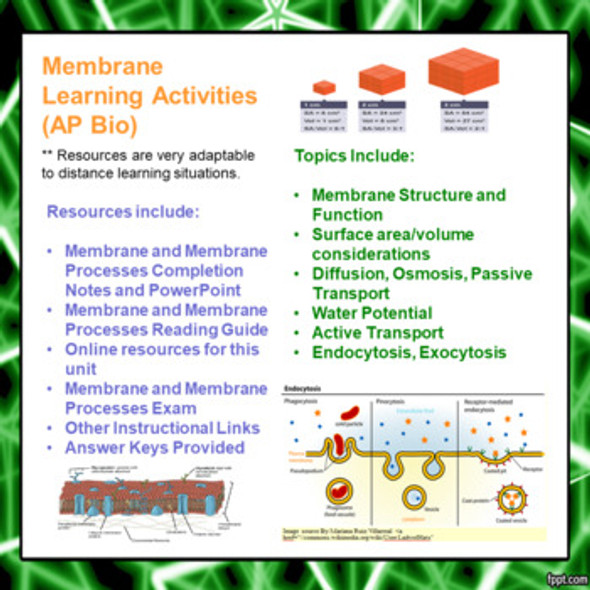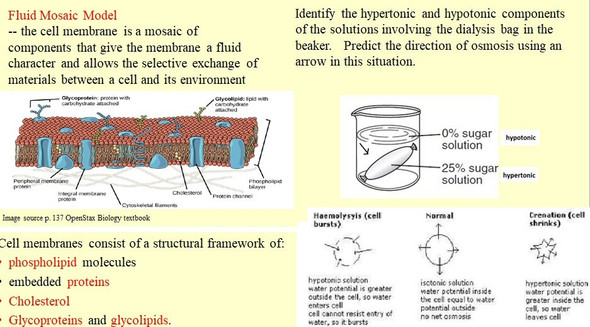Evidences for Evolution/Natural Selection Learning Activities for AP Biology (Distance Learning)
- Bulk Pricing:
- Buy in bulk and save
- Contributor:
- Monday's Rescue
- Grade Level:
- 9-12
- Product Type:
- Learning Package (Notes, PowerPoint, Homework)
- File Type:
- doc, pdf, ppt
- Pages:
- 43
- Answer Key:
- Yes
Description
This zip file contains many different activities (43 pages of student handouts and 2 PowerPoints with a total of 53 slides) which can be used to compose a unit for AP Biology or advanced Biology students involving evidences for evolution and natural selection. Some topics addressed in this unit include a discussion of evidences for evolution (fossil record, relative dating, radioactive dating, continental drift, biochemical evidence, comparative cytology and comparative embryology), Lamarck's theory of evolution, Darwin-Wallace theory of natural selection, criticisms of Darwin's theory, genetic sources of variation, evidences of evolution in modern times (peppered moth, insecticide resistance and antibiotic resistance), directional, stabilizing and diversifying selection, the concept of a gene pool, as well as many other topics. More specifics on the learning goals addressed in this learning package may be viewed near the end of this course description.
This package of activities has been updated to reflect the 2019-2020 ETS changes in the AP Biology curriculum.
While these lessons were originally designed for my AP Biology curriculum, they can be adapted to any advanced level Biology program. The Educational Testing Service also provides two labs which fit well with this unit. Links to obtain these labs are included in the "read me first" text file in this zip file package. This read me first file also contains links to an online textbook which can be used in replacement of traditional classroom textbooks.
This lesson packet contains a listing of the learning goals, common core learning standards, NGSS learning standards and the AP Biology performance indicators addressed in these materials. These are included in the packet and at the end of the description of this lesson.
The components of this lesson package can easily be displayed to students using an LCD projector and may be readily modified into formats facilitating smartboard technology. Most documents are included in both word and pdf format to allow editing for specific teacher needs.
Answer keys are included for all listed student work items. Student files have been provided in both editable word and pdf format to allow you to edit the activities to meet the needs of the students in your classroom.
The specific contents of the learning package includes the following items (the page count for these items are actual student handouts as answer key page counts are not included):
-- Learning Goals and Objectives for this unit correlated to the AP Bio ETS, NGSS and Common Core Learning standards (3 pages)
-- Evolution Completion Notes: Evidences for Evolution and Natural Selection (15 pages)
-- PowerPoint to accompany the Completion Notes (47 slides)
-- Bell ringer review PowerPoint evidences for evolution (6 slides)
-- Evolution Caught in the Act (reading and writing activity) (5 pages)
-- Evidences for Evolution and Natural Selection Worksheet (correlated to the Open Stax Biology textbook free online) (21 questions/5 pages)
-- Natural Selection and Evidences for Evolution quiz (34 multiple choice and 2 written response questions) (5 pages)
ETS AP Biology Learning Objectives
Enduring Understanding
EVO-1 Evolution is characterized by a change in the genetic makeup of a population over time and is supported by multiple lines of evidence.
EVO-2 Organisms are linked by lines of descent from common ancestry.
SYI-3 Naturally occurring diversity among and between components within biological systems affects interactions with the environment.
Learning Objectives
EVO-1.C Describe the causes of natural selection.
EVO-1.D Explain how natural selection affects populations.
EVO-1.E Describe the importance of phenotypic variation in a population.
EVO-1.F Explain how humans can affect diversity within a population.
EVO-1.G Explain the relationship between changes in the environment and evolutionary changes in the population.
EVO-1.M Describe the types of data that provide evidence for evolution.
EVO-1.N Explain how morphological, biochemical, and geological data provide evidence that organisms have changed over time.
EVO-2.B Explain how morphological, biochemical, and geological data provide evidence that organisms have changed over time.
SYI-3.A Explain the connection between variation in the number and types of molecules within cells to the ability of the organism to survive and/or reproduce in different environments.
Evolution--Natural Selection Learning Goals
Upon completion of this unit the student will be able to:
1. Explain the importance of the fossil record to the study of evolution and describe how fossils form.
2. Distinguish between relative dating and absolute dating.
3. Explain how isotopes can be used in absolute dating.
4. Explain how continental drift may have played a role in history of life.
5. Discuss how biochemistry is used to establish evolutionary relationships.
6. Describe Jean Baptiste Lamarck's model for how adaptations evolve.
7. Describe how Charles Darwin used his observations to formulate and support his theory of evolution.
8. Describe Darwin's theory of natural selection.
9. Explain what evidence convinced Darwin that species change over time.
10. Explain why variation was so important to Darwin's theory.
11. Discuss several examples of natural selection in modern times.
12. Distinguish between and list examples of directional, disruptional and stabilizing selection.
NGSS Learning Standards
Students who demonstrate understanding can:
HS-LS4-1. Communicate scientific information that common ancestry and biological evolution are supported by multiple lines of empirical evidence.
HS-LS4-2. Construct an explanation based on evidence that the process of evolution primarily results from four factors: (1) the potential for a species to increase in number, (2) the heritable genetic variation of individuals in a species due to mutation and sexual reproduction, (3) competition for limited resources, and (4) the proliferation of those organisms that are better able to survive and reproduce in the environment
HS-LS4-3. Apply concepts of statistics and probability to support explanations that organisms with an advantageous heritable trait tend to increase in proportion to organisms lacking this trait.
HS-LS4-4. Construct an explanation based on evidence for how natural selection leads to adaptation of populations.
HS-LS4-5. Evaluate the evidence supporting claims that changes in environmental conditions may result in: (1) increases in the number of individuals of some species, (2) the emergence of new species over time, and (3) the extinction of other species.
Common Core State Standards Connections:
ELA/Literacy
RST.11-12.1 Cite specific textual evidence to support analysis of science and technical texts, attending to important distinctions the author makes and to any gaps or inconsistencies in the account.
RST.11-12.8 Evaluate the hypotheses, data, analysis, and conclusions in a science or technical text, verifying the data when possible and corroborating or challenging conclusions with other sources of information.
WHST.9-12.2 Write informative/explanatory texts, including the narration of historical events, scientific procedures/ experiments, or technical processes.
WHST.9-12.9 Draw evidence from informational texts to support analysis, reflection, and research.
Mathematics
MP.2 Reason abstractly and quantitatively.
MP.4 Model with mathematics.
Terms of Use
Purchase of the product is for classroom use by the purchaser only. It is a violation for individuals, schools, and districts to redistribute, sell, or post this item on the Internet or to other individuals.
This work is licensed under a Creative Commons Attribution-NonCommercial-ShareAlike 4.0 International License.
This learning package bundle is part of the AP Biology Complete Course. The complete course contains 22 learning package bundles in addition to this one. Save nearly 60% over the cost of buying 23 individual unit learning bundles with your purchase of the complete course.
Check out Monday's Rescue for more great resources!

